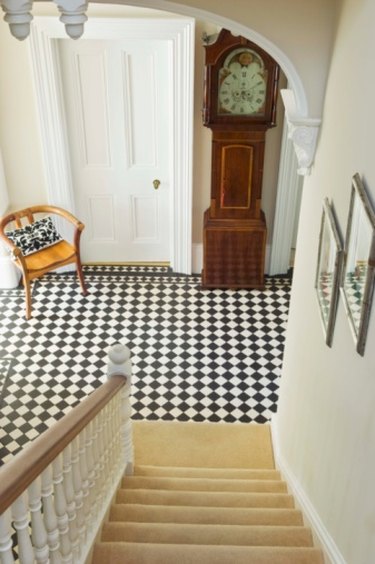Things You'll Need
Screwdriver
Hammer
180-grit sandpaper
Tack cloth
Brush
Oil-based, stain-blocking primer
Oil-based paint

Paint will stick to wood surfaces, even those that already have a coat of stain or glossy varnish. The surface has to be roughed up for proper adhesion, so taking the steps necessary to adequately prepare the finish for paint produces the best results. Roughed, scratched surfaces allow the paint to bond better and the scratches are invisible after applying paint.
Step 1
Remove cabinet doors by unscrewing the hinges. Take room doors off their hinges by tapping out the pins that hold the door in place on each hinge. Use a hammer and a screwdriver to start the pin removal, then pull them out by hand. Be careful as you remove the last pin because the door will likely spin free of its frame. Baseboard and molding is best left in place for painting since these elements are nailed in place. Since doors are removable and heavy, it's easier to prepare and finish them on a flat surface, such as a workbench or table.
Video of the Day
Step 2
Scuff the surface of the woodwork by sanding with 180-grit sandpaper. It isn't necessary to remove the old finish -- stain or varnish -- just work the paper over it enough to roughen it a little. Cover all of the woodwork to ensure even adhesion. As you progress, you will notice the stain and varnish getting more dull and a buildup of sanded material will form or fall from the item.
Step 3
Remove the buildup by wiping down the woodwork with a tack cloth, a piece of cheesecloth impregnated with resins that make it sticky. As you wipe, turn the tack cloth to make sure it stays sticky.
Step 4
Apply a coat of oil-based, stain-blocking primer with a brush to help prepare the wood to accept a top coat. Previously varnished or stained surfaces react best with oil-based primers. The stain-blockers work to hold back old stain color as well as any scuffs or marks that may be on the wood. Let the primer dry for the amount of time recommended by the manufacturer, typically overnight.
Step 5
Sand the dried primer very lightly with 180-grit sandpaper. Sand only enough to lay wood fibers back down and lightly scuff the primer so the top coat of paint will adhere better. Wipe off any sanding dust with a tack cloth.
Step 6
Brush on a coat of oil-based paint in your desired color. Cover all the primer. If a second coat is recommended or desired, be sure to allow the first coat to dry thoroughly before adding the second coat.
Step 7
Re-attach the cabinet doors by screwing the hinges back into place and re-hang doors, then insert the hinge pins after all coats of paint have dried enough for the woodwork to be handled without marring the finish.
Video of the Day